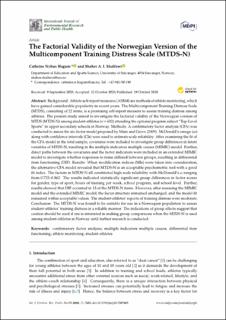| dc.contributor.author | Hagum, Cathrine Nyhus | |
| dc.contributor.author | Shalfawi, Shaher A. I. | |
| dc.date.accessioned | 2021-04-06T12:09:07Z | |
| dc.date.available | 2021-04-06T12:09:07Z | |
| dc.date.created | 2020-10-22T12:21:51Z | |
| dc.date.issued | 2020-10 | |
| dc.identifier.citation | Hagum, C.N., Shalfawi, S.A.I. (2020) The Factorial Validity of the Norwegian Version of the Multicomponent Training Distress Scale (MTDS-N). International Journal of Environmental Research and Public Health, 17 (20), 7603 | en_US |
| dc.identifier.issn | 1661-7827 | |
| dc.identifier.uri | https://hdl.handle.net/11250/2736394 | |
| dc.description.abstract | Background: Athlete self-report measures (ASRM) are methods of athlete monitoring, which have gained considerable popularity in recent years. The Multicomponent Training Distress Scale (MTDS), consisting of 22 items, is a promising self-report measure to assess training distress among athletes. The present study aimed to investigate the factorial validity of the Norwegian version of MTDS (MTDS-N) among student-athletes (n = 632) attending the optional program subject “Top-Level Sports” in upper secondary schools in Norway. Methods: A confirmatory factor analysis (CFA) was conducted to assess the six-factor model proposed by Main and Grove (2009). McDonald’s omega (ω) along with confidence intervals (CIs) were used to estimate scale reliability. After examining the fit of the CFA model in the total sample, covariates were included to investigate group differences in latent variables of MTDS-N, resulting in the multiple indicators multiple causes (MIMIC) model. Further, direct paths between the covariates and the factor indicators were included in an extended MIMIC model to investigate whether responses to items differed between groups, resulting in differential item functioning (DIF). Results: When modification indices (MIs) were taken into consideration, the alternative CFA model revealed that MTDS-N is an acceptable psychometric tool with a good fit index. The factors in MTDS-N all constituted high scale reliability with McDonald’s ω ranging from 0.725–0.862. The results indicated statistically significant group differences in factor scores for gender, type of sport, hours of training per week, school program, and school level. Further, results showed that DIF occurred in 13 of the MTDS-N items. However, after assessing the MIMIC model and the extended MIMIC model, the factor structure remained unchanged, and the model fit remained within acceptable values. The student-athletes’ reports of training distress were moderate. Conclusion: The MTDS-N was found to be suitable for use in a Norwegian population to assess student-athletes’ training distress in a reliable manner. The indications of group effects suggest that caution should be used if one is interested in making group comparisons when the MTDS-N is used among student-athletes in Norway until further research is conducted. | en_US |
| dc.language.iso | eng | en_US |
| dc.publisher | MDPI | en_US |
| dc.rights | Navngivelse 4.0 Internasjonal | * |
| dc.rights.uri | http://creativecommons.org/licenses/by/4.0/deed.no | * |
| dc.subject | sport | en_US |
| dc.subject | sport og utdanning | en_US |
| dc.title | The Factorial Validity of the Norwegian Version of the Multicomponent Training Distress Scale (MTDS-N) | en_US |
| dc.type | Peer reviewed | en_US |
| dc.type | Journal article | en_US |
| dc.description.version | publishedVersion | en_US |
| dc.rights.holder | © 2020 by the authors | en_US |
| dc.subject.nsi | VDP::Samfunnsvitenskap: 200::Samfunnsvitenskapelige idrettsfag: 330 | en_US |
| dc.source.volume | 17 | en_US |
| dc.source.journal | International Journal of Environmental Research and Public Health | en_US |
| dc.source.issue | 20 | en_US |
| dc.identifier.doi | 10.3390/ijerph17207603 | |
| dc.identifier.cristin | 1841450 | |
| dc.source.articlenumber | 7603 | en_US |
| cristin.ispublished | true | |
| cristin.fulltext | original | |
| cristin.qualitycode | 1 | |

